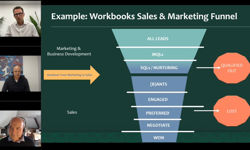In our video-obsessed consumer world – one in which 72 hours’ worth of new material is uploaded every minute to YouTube alone – for most publishers, the question of whether or not to move into video has only one answer. But there’s a difference between simply being there, and making the most of the opportunity – and that opportunity is significant.
(Pictured above, from left to right: David Moynihan, Chris Talintyre, Tim Cain, James Weeks, Tim Elkington.)
That the eyeballs are there to consume video content from publishers is clear; the Financial Times, which has sponsored videos on its home page, has 9,500 subscribers to its YouTube channel. And the Telegraph, which claims to be the most popular UK newspaper on YouTube, has more than 48,000 subscribers and its clips, covering news, entertainment, food, fashion and travel, have had more than 170 million views. The “science behind the news” gets its own YouTube channel, Whyology, and film, TV and live music reviews are at the channel Ivejustseen.
Users now expect video
“We’re in a position now where users really expect video; the written word isn’t really enough anymore,” says David Moynihan, Editor of Digital Spy, part of the Hearst stable. His title produces a range of video products including a movies section with trailers, clips and interviews, and a tech section with reviews. “It’s so much easier to watch a video where you can actually see the product. People want to really get a feel for the product, especially when it’s a high-priced item. It immediately enables people to see the scale and usability of something, and it’s just quicker as well. If you wrote all that detail, it could become a dissertation.” Click-throughs to video tend to be very high, given that consumers are already reading about a subject they’re interested in before being offered a video. The most popular videos are fairly predictable – those that cover the big tech and entertainment brands, like Apple and X Factor, but loyal audiences sharing content on social networks can make niche topics a surprise hit. “If you interview a band and fans start sharing via Twitter and Facebook, you get immense value from that,” Moynihan says. “It brings you a lot of viewers you wouldn’t otherwise have had.”
Driving the business
At Factory Media, one of Europe’s largest action sports media owners, with 19 print and 26 new media brands, the Mpora.com site for the group has become almost exclusively a video portal, with more than 70,000 videos available. The group’s individual brands post content, users can upload their own, and many videos are commissioned by advertisers and events organisers. “Increasingly we’re finding we’re acting like a production company because we have brands that will come to us and commission us to do campaigns that involve videos,” says Head of Marketing Chris Talintyre. Guides for beginners on how to get into a new sport – covering required kit, safety and basic trick tips – have been among advertiser-sponsored projects.
Factory makes its video content available, free, to other action sports sites and bloggers, each video containing an optimised backlink to the site. A syndicated player option is available to brands who upload content, and about 6,000 sites – including sports brands and events companies – embed their content. Users can customise the content they receive so that competitors’ ads don’t appear on their site.
Publishers increasing investment
So, are publishers investing in video because consumers expect no less, or is it actually a new revenue stream? “It’s a bit of both, and probably more of the first one,” says Tim Cain, Head of Research and Insight at the Association of Online Publishers. The AOP census of members last year found that nine out of ten publishers saw the reason for using video was as a core editorial proposition; some were also seeing incremental revenue from it. Eighty per cent said they were increasing their investment in video, and seeing growth particularly on sites designed for mobile and tablet usage, because of the quality of the viewing experience on tablets.
The challenge facing publishers is not really in getting consumers to watch video. Audiences are there and, in many cases, the ability to offer new kinds of content in addition to words and photos is bringing greater distribution opportunities that all feed back to the parent brand. Demand for digital video is steadily climbing; Juniper Research recently forecast that more than 2 billion consumers will be regularly viewing video content on their mobiles within the next four years, with younger demographics watching through social networks, an especially strong growth sector.
Evolving strategies
The real test, then, is in determining how best to make the demand for quality video pay. Monetising video is in its infancy, and the optimum business model for achieving it is yet to become clear. What is clear is that advertisers are delighted with the high levels of engagement and long dwell times that video is delivering. Advertising space around video – whether that’s pre-roll, TV-style commercials or skins – a branded frame around the video – is usually sold at a premium to other online inventory, and is highly popular.
“We've discovered that duration is not necessarily a barrier to consumption, but the content has to be right for it,” says James Weeks, Head of Video, Telegraph Media Group. “Advertisers like video because it results in long dwell times. Play-through rates vary quite significantly depending on the type of material, and we have a large variety.” The Telegraph uses the usual pre-roll ad formats and in-skin units, plus sponsorships of whole channels, and makes branded content for ad clients.
Tim Cain at the AOP says the big money in online video for now remains in pre-roll and sponsorship. “It’s effective,” he says. “People just become familiar with it and expect it as part of the proposition.” Skip-able ads, which can be stopped after a few seconds if the viewer wants to go straight to their chosen video, present new creative challenges to those coming up with the ads.
Exponential ad growth
The Internet Advertising Bureau reports that online video generated £160 million last year, up significantly from £109 million in 2011 and up from just £12 million in 2008, the first year that it was measured. IAB Director of Research and Strategy Tim Elkington expects that as 4G becomes more widely available, and as more mobile phone packages include unlimited data usage, demand for video – from consumers and then, in turn, from advertisers – will quicken. The IAB is forecasting digital advertising to grow at 20-40 per cent a year for the next couple of years, but predicts mobile advertising will see triple-digit growth fuelled by an explosion in the number of people who can watch video content via mobile.
“Even though pre and post (pre-roll and post-roll advertising) is definitely the work horse of online video, publishers are looking for other ways to monetise it,” says Elkington. Branded video players are increasingly popular, along with video designed to be shared via social media.
At Factory Media, Chris Talintyre says pre-roll goes hand-in-hand with video content, but media companies have to be careful not to overdo it and risk irritating consumers. Advertisers love the association with video on a specialist publisher’s site, he says. “It’s very tailored around what they’re trying to sell, and it’s seen by a committed core audience.” Branded content can also be “accelerated”, that is seeded out to the industry on behalf of clients who particularly want to build up viewing numbers fast. Video is now at the heart of the business operation, Talintyre says. “It certainly represents a significant proportion of our online revenue … and video has been a very lucrative area. We do still sell display but increasingly we bundle that around a creative proposal. There’s a higher cost of producing video but interaction rates of 7-10% on pre-roll are not uncommon.”
At Digital Spy, Moynihan says video is proving “absolutely profitable”. The title’s video team of two people within the editorial team is producing 150 pieces of video content a month. Digital Spy has more than a million streams per month. “They’re very busy and I think they need to be to make sure we’re delivering the amount of inventory we need.” Advertisers, he says, are loving it. Their options at the moment are pre-roll, in-skin and sponsorship; Kellogg’s have recently sponsored a breakfast video. “For advertisers, it’s crucial that they’re advertising in the richest and most cutting-edge ways,” Moynihan says. “Within the online budget, people want and expect a lot more. The days of just buying some display and being done with it seems quite outdated today.”
Developments in the application of pre-roll are interesting; giving consumers a choice of which pre-roll ad they want to watch will immediately put brands in contact with an audience more likely to have engagement with them, and there are payment models under which the client only pays if the entire ad is watched by the viewer.
Premium solutions vs ad networks
The effect of all this excitement around video on old-fashioned display advertising, Tim Elkington says, is almost polarising. The really premium, bespoke solutions created for prominent brands will retain their appeal. At the other end of the spectrum, it’s likely that inventory will increasingly be sold through ad networks, providing advertisers with massive reach at substantially lower rates than the premium solutions. “Research shows a companion buy of display and video to be effective,” Elkington says. “To some extent, it always comes back to quality content. If you can get good audiences, it will increase engagement and get more interest from advertisers.”
The other thing that engaging content could well bring is not just big consumer audiences, but audiences who are prepared to pay to view it. Just as the publishing world has been grappling with paid, free and “freemium” models for the provision of online text and pictures, payment models are emerging for video content too. Factory Media plans to start selling video packages of event highlights directly and through Facebook.
But it’s YouTube’s decision to introduce a subscription model as an option for some channel owners that could really transform business models for video publishers. In the same way as consumers can rent films via YouTube, subscriptions starting at about £1 a month are available under the scheme, which is still in its infancy. The model works along similar lines to the way advertising revenues on YouTube are divided, or apps are sold from the Apple app store. In the case of subscriptions, the channel owner gets 55 per cent of takings, and YouTube gets 45 per cent. Whether or not to serve ads as well as take a subscription fee remains up to participating channels.
But, with the debate still raging over consumers’ willingness to pay for quality written editorial content when so much on the internet is free, it remains to be seen just how many will be willing to pay how much for the video content they so want.












